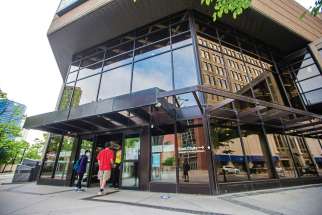Return to office a work in progress for Manitoba civil servants Employees' concerns should guide post-pandemic workplace, union says
Read this article for free:
or
Already have an account? Log in here »
To continue reading, please subscribe:
Monthly Digital Subscription
$0 for the first 4 weeks*
- Enjoy unlimited reading on winnipegfreepress.com
- Read the E-Edition, our digital replica newspaper
- Access News Break, our award-winning app
- Play interactive puzzles
*No charge for 4 weeks then price increases to the regular rate of $19.00 plus GST every four weeks. Offer available to new and qualified returning subscribers only. Cancel any time.
Monthly Digital Subscription
$4.75/week*
- Enjoy unlimited reading on winnipegfreepress.com
- Read the E-Edition, our digital replica newspaper
- Access News Break, our award-winning app
- Play interactive puzzles
*Billed as $19 plus GST every four weeks. Cancel any time.
To continue reading, please subscribe:
Add Free Press access to your Brandon Sun subscription for only an additional
$1 for the first 4 weeks*
*Your next subscription payment will increase by $1.00 and you will be charged $16.99 plus GST for four weeks. After four weeks, your payment will increase to $23.99 plus GST every four weeks.
Read unlimited articles for free today:
or
Already have an account? Log in here »
Hey there, time traveller!
This article was published 26/07/2021 (1594 days ago), so information in it may no longer be current.
COVID-19 infections may be winding down, but the Manitoba government isn’t compelling civil servants to return to the workplace.
It’s part of a new policy that could set the tone for how Manitobans return to the office.
“As hard as it was to leave the workplace, it’s going to be just as hard to return to the workplace,” said Michelle Gawronsky, president of the Manitoba Government and General Employees’ Union, which represents most public servants.
The province issued a flexible work policy this month. It asks employees to submit a formal request on how often they’d like to show up at the office, and if they prefer to adjust their working hours.
The Civil Service Commission introduced the policy to roughly 12,800 public servants on July 5.
The document asks supervisors to approve requests that don’t affect productivity or cause excessive costs to the province. It includes checklists to make sure employees have adequate Internet and insurance to work from home.
Central Services Minister Reg Helwer said government departments evaluated productivity as many employees worked from home.
“We’re just currently going through evaluating what worked for staff, and what worked for the government,” Helwer said.
Internal data obtained by the Free Press show 5,029 government employees — 39 per cent of the workforce — were working remotely, in part or in whole, as of June. That’s down from the peak, April 2020, when 5,350 staff worked from home.
The number of public servants working from home has generally risen as COVID-19 case rates increased and restrictions were imposed.
In May, 80 per cent of civil servants who worked from home spent six or more business days out of the office. Thirty-two per cent worked 12 to 15 days from home.
The government and union say the adaptation has had mixed success. Some staff thrive at home, while others clamour to return to the office.
Gawronsky said the most common issue employees have raised since March 2020 is a lack of communication from their supervisors.
Managers have grappled with trying to keep in touch with employees who are in different locations, while lower-level staff have had to request virtual meetings to review minor issues.
Outside Winnipeg and Brandon, unreliable Internet has hindered work, Gawronsky said.
The new policy doesn’t propose targets, and MGEU has not heard about staff being pushed toward working from home or returning to the office. Gawronsky hopes that’s a sign the province doesn’t have a predetermined plan.
“I believe they’re working their way through this, just as much as anyone else is,” said Gawronsky. “I think they’re actually doing some homework.”
Clerical and finance staff have become used to working remotely.
In fact, employers and supervisors in multiple departments report they’ve often been asked what the other expects, with neither having a clear idea of how to return to work.
“It’s pretty widespread, and it is both full- and part-time work from home for permanent staff, and there might be a combination for working from home (such as) three days a week,” Helwer said.
The policy asks employees to verify that they have adequate heating and Internet to work from home responsibly, and shoulder the burden of paying for renovations to establish a remote workplace. Employees must agree to show up at the office “when requested for meetings, training and/or at supervisor’s discretion, with reasonable notice.”
Supervisors must check that staff follow all policies on retaining government records and keeping them secure while working remotely, and that the arrangement “does not generate unreasonable cost to government.”
As examples, a department can pay to expand its virtual private network to secure an employee’s home internet connection, but it should not buy printers for staff.
The government wants everyone involved to document all work-from-home proposals and agreements in writing, and assess the arrangements monthly during a trial period. From then on, managers are asked to assess the arrangement once a year, and staff can’t automatically take their arrangement into a new government job.
No plan to sell buildings: Tories
Manitoba’s largest union says it wonders whether the provincial government will sell office space, but the province insists has no immediate plan to do so.
“So far, we haven’t seen a lot of changes in our footprint requirements, but those are all being evaluated,” said Central Services Minister Reg Helwer, whose job involves finding efficiencies.
In April, the province closed 21 agriculture offices in rural areas.
Michelle Gawronsky, head of the Manitoba Government and General Employees’ Union, said she’s worried the province will merge government offices to save costs, and possibly slash front-line staffing numbers.
Manitobans currently face long wait times for services such as vital statistics and employment insurance assistance, as both often involve records that might not be available in digital form.
The province is reviewing its office space needs, but there’s no plan to sell buildings as a result of staff working from home, Helwer said.
“Sometimes we also need larger space because we need to have people separated a little bit more right now, and we don’t know how long that’s going to last,” Helwer said, adding the immediate focus is on expanding front-line services as restrictions loosen.
“Flexible work arrangements must not alter the employee’s terms and conditions of employment, including the overall number of hours worked by the employee or the nature of the employee’s work responsibilities,” reads the policy.
Personally, Gawronsky said she checks email at all hours, and boots up her laptop during evenings to do one more task.
She worries managers and even colleagues could be pressuring employees to work at all hours, which she says will lead to burnout.
“I don’t want working at home to become living at work,” she said.
“We’re going to have to really set some parameters in place, and we are all going to have to honour those parameters.”
Gawronsky said she expects working arrangements to become part of contract talks: employees might want to work from home a certain amount of time, there might be stipulations about whether employers must provide ergonomic equipment, she said.
It might include a threshold for the number of employees required in an office, to avoid a situation where a minority of workers who can’t work from home lose office space because the majority don’t see the need for it.
Those eager to return to the world of water-coolers and bagged lunches will have to contend with finding child care and making the daily commute, Gawronsky said.
It gets murkier when it comes to whether employees should know if their colleagues are vaccinated, and if an office should suddenly go to full capacity overnight.
“We are looking for government to be providing some guidelines into that, both federally and provincially,” she said.
So far, federal and provincial labour ministers have acknowledged the need to provide guidance on a safe return to work, but there are few specifics.
No province appears to have a detailed plan.
Gawronsky wants the Pallister government to consult the public on what services they need as the pandemic winds down.
“I’m certainly hoping they put away their ideologies, and do what’s right,” she said, urging labour leaders to similarly come to the table with an open mind.
“We need to make sure we can be flexible and willing to bend for each other, to make this happen.”
dylan.robertson@freepress.mb.ca
Flexible Work Arrangements policy, safety checklist and internal data







